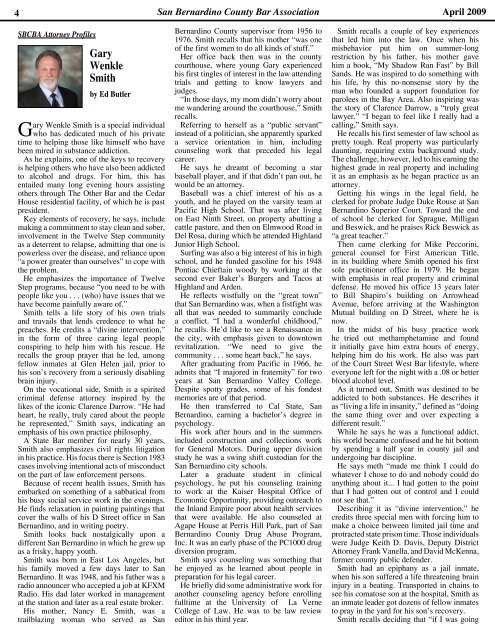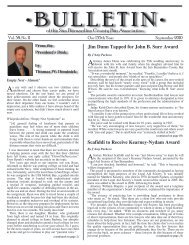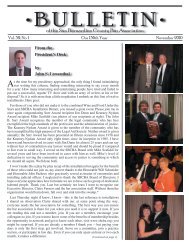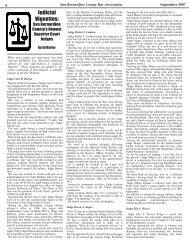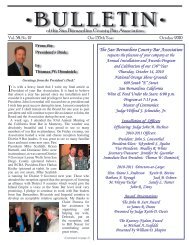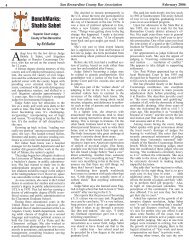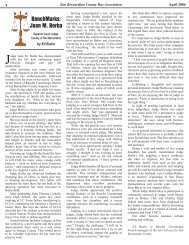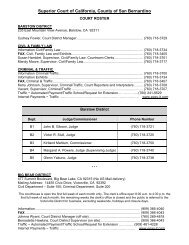April 2009 - San Bernardino County Bar Association
April 2009 - San Bernardino County Bar Association
April 2009 - San Bernardino County Bar Association
- No tags were found...
You also want an ePaper? Increase the reach of your titles
YUMPU automatically turns print PDFs into web optimized ePapers that Google loves.
4 <strong>San</strong> <strong>Bernardino</strong> <strong>County</strong> <strong>Bar</strong> <strong>Association</strong> <strong>April</strong> <strong>2009</strong>SBCBA Attorney ProfilesGaryWenkleSmithby Ed ButlerGary Wenkle Smith is a special individualwho has dedicated much of his privatetime to helping those like himself who havebeen mired in substance addiction.As he explains, one of the keys to recoveryis helping others who have also been addictedto alcohol and drugs. For him, this hasentailed many long evening hours assistingothers through The Other <strong>Bar</strong> and the CedarHouse residential facility, of which he is pastpresident.Key elements of recovery, he says, includemaking a commitment to stay clean and sober,involvement in the Twelve Step communityas a deterrent to relapse, admitting that one ispowerless over the disease, and reliance upon“a power greater than ourselves” to cope withthe problem.He emphasizes the importance of TwelveStep programs, because “you need to be withpeople like you . . . (who) have issues that wehave become painfully aware of.”Smith tells a life story of his own trialsand travails that lends credence to what hepreaches. He credits a “divine intervention,”in the form of three caring legal peopleconspiring to help him with his rescue. Herecalls the group prayer that he led, amongfellow inmates at Glen Helen jail, prior tohis son’s recovery from a seriously disablingbrain injury.On the vocational side, Smith is a spiritedcriminal defense attorney inspired by thelikes of the iconic Clarence Darrow. “He hadheart, he really, truly cared about the peoplehe represented,” Smith says, indicating anemphasis of his own practice philosophy.A State <strong>Bar</strong> member for nearly 30 years,Smith also emphasizes civil rights litigationin his practice. His focus there is Section 1983cases involving intentional acts of misconducton the part of law enforcement persons.Because of recent health issues, Smith hasembarked on something of a sabbatical fromhis busy social service work in the evenings.He finds relaxation in painting paintings thatcover the walls of his D Street office in <strong>San</strong><strong>Bernardino</strong>, and in writing poetry.Smith looks back nostalgically upon adifferent <strong>San</strong> <strong>Bernardino</strong> in which he grew upas a frisky, happy youth.Smith was born in East Los Angeles, buthis family moved a few days later to <strong>San</strong><strong>Bernardino</strong>. It was 1948, and his father was aradio announcer who accepted a job at KFXMRadio. His dad later worked in managementat the station and later as a real estate broker.His mother, Nancy E. Smith, was atrailblazing woman who served as <strong>San</strong><strong>Bernardino</strong> <strong>County</strong> supervisor from 1956 to1976. Smith recalls that his mother “was oneof the first women to do all kinds of stuff.”Her office back then was in the countycourthouse, where young Gary experiencedhis first tingles of interest in the law attendingtrials and getting to know lawyers andjudges.“In those days, my mom didn’t worry aboutme wandering around the courthouse,” Smithrecalls.Referring to herself as a “public servant”instead of a politician, she apparently sparkeda service orientation in him, includingcounseling work that preceded his legalcareer.He says he dreamt of becoming a starbaseball player, and if that didn’t pan out, hewould be an attorney.Baseball was a chief interest of his as ayouth, and he played on the varsity team atPacific High School. That was after livingon East Ninth Street, on property abutting acattle pasture, and then on Elmwood Road inDel Rosa, during which he attended HighlandJunior High School.Surfing was also a big interest of his in highschool, and he funded gasoline for his 1948Pontiac Chieftain woody by working at thesecond ever Baker’s Burgers and Tacos atHighland and Arden.He reflects wistfully on the “great town”that <strong>San</strong> <strong>Bernardino</strong> was, when a fistfight wasall that was needed to summarily concludea conflict. “I had a wonderful childhood,”he recalls. He’d like to see a Renaissance inthe city, with emphasis given to downtownrevitalization. “We need to give thecommunity . . . some heart back,” he says.After graduating from Pacific in 1966, headmits that “I majored in fraternity” for twoyears at <strong>San</strong> <strong>Bernardino</strong> Valley College.Despite spotty grades, some of his fondestmemories are of that period.He then transferred to Cal State, <strong>San</strong><strong>Bernardino</strong>, earning a bachelor’s degree inpsychology.His work after hours and in the summersincluded construction and collections workfor General Motors. During upper divisionstudy he was a swing shift custodian for the<strong>San</strong> <strong>Bernardino</strong> city schools.Later a graduate student in clinicalpsychology, he put his counseling trainingto work at the Kaiser Hospital Office ofEconomic Opportunity, providing outreach tothe Inland Empire poor about health servicesthat were available. He also counseled atAgape House at Perris Hill Park, part of <strong>San</strong><strong>Bernardino</strong> <strong>County</strong> Drug Abuse Program,Inc. It was an early phase of the PC1000 drugdiversion program.Smith says counseling was something thathe enjoyed as he learned about people inpreparation for his legal career.He briefly did some administrative work foranother counseling agency before enrollingfulltime at the University of La VerneCollege of Law. He was to be law revieweditor in his third year.Smith recalls a couple of key experiencesthat led him into the law. Once when hismisbehavior put him on summer-longrestriction by his father, his mother gavehim a book, “My Shadow Ran Fast” by Bill<strong>San</strong>ds. He was inspired to do something withhis life, by this no-nonsense story by theman who founded a support foundation forparolees in the Bay Area. Also inspiring wasthe story of Clarence Darrow, a “truly greatlawyer.” “I began to feel like I really had acalling,” Smith says.He recalls his first semester of law school aspretty tough. Real property was particularlydaunting, requiring extra background study.The challenge, however, led to his earning thehighest grade in real property and includingit as an emphasis as he began practice as anattorney.Getting his wings in the legal field, heclerked for probate Judge Duke Rouse at <strong>San</strong><strong>Bernardino</strong> Superior Court. Toward the endof school he clerked for Sprague, Milliganand Beswick, and he praises Rick Beswick as“a great teacher.”Then came clerking for Mike Peccorini,general counsel for First American Title,in its building where Smith opened his firstsole practitioner office in 1979. He beganwith emphasis in real property and criminaldefense. He moved his office 13 years laterto Bill Shapiro’s building on ArrowheadAvenue, before arriving at the WashingtonMutual building on D Street, where he isnow.In the midst of his busy practice workhe tried out methamphetamine and foundit initially gave him extra hours of energy,helping him do his work. He also was partof the Court Street West <strong>Bar</strong> lifestyle, whereeveryone left for the night with a .08 or betterblood alcohol level.As it turned out, Smith was destined to beaddicted to both substances. He describes itas “living a life in insanity,” defined as “doingthe same thing over and over expecting adifferent result.”While he says he was a functional addict,his world became confused and he hit bottomby spending a half year in county jail andundergoing bar discipline.He says meth “made me think I could dowhatever I chose to do and nobody could doanything about it... I had gotten to the pointthat I had gotten out of control and I couldnot see that.”Describing it as “divine intervention,” hecredits three special men with forcing him tomake a choice between limited jail time andprotracted state prison time. Those individualswere Judge Keith D. Davis, Deputy DistrictAttorney Frank Vanella, and David McKenna,former county public defender.Smith had an epiphany as a jail inmate,when his son suffered a life threatening braininjury in a beating. Transported in chains tosee his comatose son at the hospital, Smith asan inmate leader got dozens of fellow inmatesto pray in the yard for his son’s recovery.Smith recalls deciding that “if I was going


